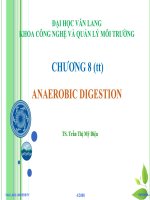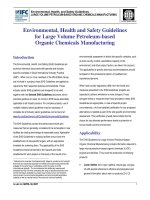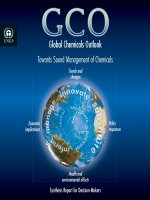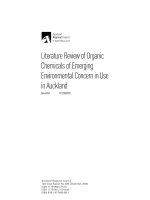FINE CHEMICALS ppt
Bạn đang xem bản rút gọn của tài liệu. Xem và tải ngay bản đầy đủ của tài liệu tại đây (4.5 MB, 296 trang )
FINE CHEMICALS
ffirs.indd iffirs.indd i 12/17/2010 10:28:52 AM12/17/2010 10:28:52 AM
FINE CHEMICALS
SECOND EDITION
Peter Pollak, PhD
Reinach, Switzerland
A JOHN WILEY & SONS, INC., PUBLICATION
THE INDUSTRY AND
THE BUSINESS
ffirs01.indd iiiffirs01.indd iii 12/17/2010 10:28:52 AM12/17/2010 10:28:52 AM
Copyright © 2011 by John Wiley & Sons, Inc. All rights reserved.
Published by John Wiley & Sons, Inc., Hoboken, New Jersey.
Published simultaneously in Canada.
No part of this publication may be reproduced, stored in a retrieval system, or transmitted in
any form or by any means, electronic, mechanical, photocopying, recording, scanning, or
otherwise, except as permitted under Section 107 or 108 of the 1976 United States Copyright
Act, without either the prior written permission of the Publisher, or authorization through
payment of the appropriate per-copy fee to the Copyright Clearance Center, Inc., 222
Rosewood Drive, Danvers, MA 01923, (978) 750-8400, fax (978) 646-8600, or on the Web at
www.copyright.com. Requests to the Publisher for permission should be addressed to the
Permissions Department, John Wiley & Sons, Inc., 111 River Street, Hoboken, NJ 07030, (201)
748-6011, fax (201) 748-6008, or online at www.wiley.com/go/permissions.
Limit of Liability/Disclaimer of Warranty: While the publisher and author have used their best
efforts in preparing this book, they make no representations or warranties with respect to the
accuracy or completeness of the contents of this book and specifi cally disclaim any implied
warranties of merchantability or fi tness for a particular purpose. No warranty may be created
or extended by sales representatives or written sales materials. The advice and strategies
contained herein may not be suitable for your situation. You should consult with a professional
where appropriate. Neither the publisher nor author shall be liable for any loss of profi t or any
other commercial damages, including but not limited to special, incidental, consequential, or
other damages.
For general information on our other products and services or for technical support, please
contact our Customer Care Department within the United States at (800) 762-2974, outside the
United States at (317) 572-3993 or fax (317) 572-4002.
Wiley also publishes its books in a variety of electronic formats. Some content that appears in
print may not be available in electronic books. For more information about Wiley products, visit
our web site at www.wiley.com.
Library of Congress Cataloging-in-Publication Data:
Fine chemicals : the industry and the business/edited by Peter Pollak.—2nd ed.
p. cm.
ISBN 978-0-470-62767-9 (cloth)
1. Chemicals. 2. Chemical engineering. 3. Chemical industry. I. Pollak, Peter, 1934–
TP200.F525 2010
660—dc22
2010033575
Printed in Singapore
10 9 8 7 6 5 4 3 2 1
ffirs02.indd ivffirs02.indd iv 12/20/2010 10:11:59 AM12/20/2010 10:11:59 AM
To Maria, Barbara, and Paolo
ffirs03.indd vffirs03.indd v 12/17/2010 10:28:53 AM12/17/2010 10:28:53 AM
CONTENTS
PREFACE TO THE SECOND EDITION xi
PREFACE TO THE FIRST EDITION xiii
ACKNOWLEDGMENTS xv
PART I THE INDUSTRY 1
1. What Fine Chemicals Are 3
1.1 Defi nition 3
1.2 Positioning on the Value-Added Chain 5
2. The Fine Chemical Industry 8
2.1 Industry Structure 8
2.2 Fine Chemical/Custom Manufacturing Companies 9
2.3 Contract Research Organizations 15
2.4 Laboratory Chemical Suppliers 20
2.5 Mergers and Acquisitions (M&A) 21
3. Products 26
3.1 Small Molecules 26
3.2 Big Molecules 28
4. Technologies 32
4.1 Traditional Chemical Synthesis 32
4.2 Biotechnology 38
5. Facilities and Plants 49
5.1 Plant Design 49
5.2 Plant Operation 61
6. Research and Development 66
6.1 Objectives 67
6.2 Project Initiation 71
6.3 Project Execution and Management 71
vii
ftoc.indd viiftoc.indd vii 12/17/2010 10:28:55 AM12/17/2010 10:28:55 AM
viii CONTENTS
7. Cost Calculation 75
7.1 Investment Cost 75
7.2 Manufacturing Costs 76
8. Management Aspects 81
8.1 Risk/Reward Profi le 83
8.2 Performance Metrics and Benchmarking 86
8.3 Organization 88
Bibliography 91
PART II THE BUSINESS 93
9. Market Size and Structure 95
9.1 Fine Chemical Market Size 95
9.2 Market Breakdown by Major Applications 97
10. The Business Condition 100
10.1 Offer 101
10.2 Demand 103
11. Customer Base 107
11.1 Pharmaceutical Industry 107
11.2 Agrochemical Industry 115
11.3 Animal Health Industry 120
11.4 Other Specialty Chemical Industries 123
11.4.1 Adhesives and Sealants 126
11.4.2 Biocides 126
11.4.3 Catalysts and Enzymes 128
11.4.4 Dyestuffs and Pigments 131
11.4.5 Electronic Chemicals 132
11.4.6 Flavors and Fragrances (F&F) 134
11.4.7 Food and Feed Additives 136
11.4.8 Specialty Polymers 138
12. Marketing 141
12.1 Organization and Tasks 141
12.2 Target Products and Services 145
12.2.1 Exclusives: Custom Manufacturing 147
12.2.2 Nonexclusives: API-for-Generics 150
12.2.3 Standard Products 156
ftoc.indd viiiftoc.indd viii 12/17/2010 10:28:55 AM12/17/2010 10:28:55 AM
CONTENTS ix
12.3 Target Markets: Geographic Regions and Customer
Categories 156
12.4 Distribution Channels 162
12.5 Pricing 163
12.6 Intellectual Property Rights 169
12.7 Supply Contracts 170
12.8 Promotion 173
12.9 Network and Contact Development 175
12.10 Key Account Management 176
Bibliography 178
PART III
OUTLOOK 179
13. General Trends and Growth Drivers 181
14. Globalization 184
14.1 Western Hemisphere 189
14.2 Eastern Hemisphere 192
14.3 Cooperation Models 195
15. Biotechnology 198
15.1 Small Molecules (White Biotechnology) 198
15.2 Big Molecules (Biopharmaceuticals) 199
16. Ethical Pharmaceutical Industry 203
16.1 Restructuring and Outsourcing 205
16.2 R&D Productivity 207
16.3 Business Impact 215
17. Generics 217
17.1 Small Molecule Generics 217
17.2 Biosimilars 221
18. Other Life Science Industries 224
18.1 Agro Fine Chemicals 224
18.2 Animal Health Industry 226
19. Contract Research Organizations 228
20. Conclusion: Who Is Fittest for the Future? 231
ftoc.indd ixftoc.indd ix 12/17/2010 10:28:55 AM12/17/2010 10:28:55 AM
x CONTENTS
Bibliography 236
Abbreviations 237
APPENDICES 241
A.1 Information Sources/Life Sciences 243
A.2 Checklist for New Product Evaluation 248
A.3 Project Schedule, Custom Manufacturing Project 250
A.4 Company Scorecard 252
A.5 Job Description for Business Development Manager 254
A.6 Checklist for the Selection of Outsourcing Partners 256
A.7 Checklist for the Manufacture of Nonregulated (or Basic GMP)
Fine Chemicals 257
A.8 Checklist for Customer Visit 258
A.9 Outline for a Company Presentation 260
A.10 Overseas Expansion of Indian Pharma and
Fine Chemical Companies 261
A.11 Asian Expansion of Western Fine Chemical Companies 263
INDEX 265
NOTE:
US$ Exchange rates
CHF 1 = US$ 0.966
€
1 = US$ 1.44 INR 100 = US$ 2.15 £ 1 = US$ 1.52
ftoc.indd xftoc.indd x 12/20/2010 2:19:04 PM12/20/2010 2:19:04 PM
PREFACE TO THE SECOND EDITION
This revised edition has been prepared in order to provide the reader with an
updated view of the fi ne chemical industry and business. Actually, the most
recent data used in the fi rst edition go up to 2005. Since then, both the fi ne
chemicals industry itself and its customers have undergone substantial changes:
The business as a whole is more competitive now due to the escalating impact
of low - cost players from the Far East on the one hand, and the passing - on of
the price pressure the life science industry is subject to itself on the other hand.
Many Western fi ne chemical companies or divisions created during the “ irra-
tional exuberance ” at the turn of the millennium have exited from the sector.
As described in Section 5.2 , Plant Operation, the most progressive companies
adopt lean production principles originally developed by the automotive
industry. In this context, Section 7.2 , Manufacturing Costs, has also been
refi ned. As described in the new Section 2.5 , Mergers and Acquisitions, the
M & A scenario has inverted from a seller ’ s to a buyer ’ s market. Private equity
fi rms have become owners of a number of fi ne chemical companies. The busi-
ness model of the fi ne chemical industry has broadened and now often includes
also contract research at the beginning and active ingredient formulation
toward the end of the value - added chain. This development is not fi nding
unanimous approval by industry experts. Biotechnology now plays a bigger
role. In the synthesis of small molecules, the use of enzymes has become more
widespread as it enables both a more sustainable and economic production.
Big molecules have fi rmly established themselves as active ingredients in the
life science industry. Thus, biopharmaceuticals now account for fi ve of the ten
top selling pharmaceuticals. To the detriment of originator drugs and agro-
chemicals, the market share of generics has increased. It now also comprises
generic versions of biopharmaceuticals (see the new Section 17.2 , Biosimilars).
Faced with slower growth, patent expirations of many lucrative blockbuster
drugs, and stalling new product launches, leading pharmaceutical companies
are facing challenges as never before. They react by implementing restructur-
ing programs. These comprise, among others, reduction of their in - house
chemical manufacturing and plant eliminations. Outsourcing of chemical man-
ufacturing has moved up from a purely opportunistic to a strategic approach.
Apart from restructuring, globalization is also affecting the fi ne chemicals
industry (see Chapter 14 ) . In the pharm - emerging countries, double - digit
growth of the consumption of pharmaceuticals and agrochemicals — and the
production of their active ingredients — is taking place. With their combination
xi
fpref.indd xifpref.indd xi 12/17/2010 10:28:54 AM12/17/2010 10:28:54 AM
xii PREFACE TO THE SECOND EDITION
of 40% of the world ’ s population and the “ low - cost/high - skill/high - future ”
industrial base, they represent a great challenge to the European and U.S. fi ne
chemicals industry. A business condition could develop, whereby even “ best -
in - class ” midsized, family - owned fi ne chemical companies with superior tech-
nology portfolios and footholds in Asia could be relegated to producing small
quantities of fi ne chemicals for new life science products in late stages of
development (see Chapter 20 ).
Peter Pollak
fpref.indd xiifpref.indd xii 12/17/2010 10:28:54 AM12/17/2010 10:28:54 AM
PREFACE TO THE FIRST EDITION
This book provides an insider ’ s view of the status of the fi ne chemical industry,
as well as its outlook. It covers all aspects of this dynamic industry, with all of
its stakeholders in mind, viz. employees, customers, suppliers, investors, stu-
dents and educators, media representatives, neighboring communities, public
offi cials, and anyone else who has an interest in this segment of the chemical
industry. Safety, health, environmental, and regulatory issues are discussed
only briefl y, as the related subjects are extensively covered in the specialized
literature.
The main raison d ’ ê tre of the fi ne chemical industry is to satisfy the product
and process development needs of the specialty chemicals, especially the life
science (primarily pharmaceutical and agrochemical) industry. Sales outside
the chemical industry remain the exception. The fi ne chemical industry has
evolved mainly because of the rapid growth of the Anglo - Saxon pharmaceuti-
cal industry, which traditionally has been more inclined to outsourcing chemi-
cal manufacturing than the continental European one — and the increasing
complexity of the drug molecules. The roots of both the term “ fi ne chemicals ”
and the emergence of the industry as a distinct entity date back to the late
1970s, when the overwhelming success of the histamine H
2
receptor antago-
nists Tagamet (cimetidine) and Zantac (ranitidine hydrochloride) created a
strong demand for advanced intermediates used in their manufacturing
processes. The two drugs cure stomach ulcers, thus eliminating the need for
surgical removal of ulcers. As the in - house production capacities of the origi-
nators, Smith, Kline & French and Glaxo, could not keep pace with the rapidly
increasing requirements, both companies outsourced part of the synthesis to
chemical companies in Europe and Japan experienced in producing relatively
sophisticated organic molecules. Also, the fl edgling generics industry had no
captive production of active pharmaceutical ingredients (APIs) and purchased
their requirements. Moreover, the growing complexity of pharmaceutical and
agrochemical molecules and the advent of biopharmaceuticals had a major
impact on the evolution of the fi ne chemical industry as a distinct entity.
Custom manufacturing, respectively its counterpart, outsourcing, has remained
the K ö nigsdisziplin (i.e., the most prominent activity) of the fi ne chemical
industry and “ make or buy ” decisions have become an integral part of the
supply chain management process. The fi ne chemical industry has its own
characteristics with regard to R & D, production, marketing, and fi nance. The
total turnover of the largest companies, respectively business units does not
xiii
fpref.indd xiiifpref.indd xiii 12/17/2010 10:28:54 AM12/17/2010 10:28:54 AM
xiv PREFACE TO THE FIRST EDITION
exceed a few hundred million dollars per year. The fi ne chemical industry sup-
plies advanced intermediates and active substances, frequently on an exclusive
basis, to the pharmaceutical, agrochemical, and other specialty - chemical indus-
tries. Further distinctions are batch production in campaigns, high asset inten-
sity, and above - industry - average R & D expenditures. The industry is still
located primarily in Europe. Custom manufacturing prevails in northern
Europe; the manufacture of active substances for generics, in southern Europe.
As of today, the majority of the global $85 billion production value of fi ne
chemicals continues to be covered by captive production, leaving a business
potential of $60 billion for the fi ne chemical industry … on top of the inherent
growth of the existing business. Despite this huge business opportunity, the
fi ne chemical industry is challenged by overcapacity and intense competition.
As a result of early riches, many chemical companies sought relief from their
dependence on cyclical commodities by diversifying into higher - value - added
products, like fi ne chemicals. At present, the industry is going through two
interconnected changes. In terms of geography, Far Eastern “ high - skill/low -
cost ” companies are emerging as serious competitors. In terms of structure,
the chemical conglomerates are divesting their (often loss - making) fi ne chemi-
cal businesses. They are becoming mostly privately owned pure players.
Although the demand has not grown to the extent initially anticipated, fi ne
chemicals still provide attractive opportunities to well - run companies, which
are fostering the critical success factors, namely running fi ne chemicals as core
business, making niche technologies — primarily biotechnology — a part of their
business and developing assets in Asia.
Peter Pollak
fpref.indd xivfpref.indd xiv 12/17/2010 10:28:54 AM12/17/2010 10:28:54 AM
ACKNOWLEDGMENTS
SECOND EDITION
For the preparation of the second edition of this book, I am indebted to a
number of colleagues, who, as experts in specifi c fi elds, provided me with their
very valuable inputs: Rolf Dach, Boehringer Ingelheim; Jacques Gosteli,
Cerecon AG; Vihari Purushothaman, Enam Securities Pvt Ltd.; Wilfried Eul
and Dan Ostgard, Evonik Degussa; Anish Swadi, Hikal Ltd, Stefan Stoffel and
Robert Voeffray, Lonza Ltd.; Ian Shott, Shott Consulting, Andrew Warmington,
Speciality Chemicals Magazine , and Dimitrios Kalias, Vio Chemicals Ltd.
FIRST EDITION
I would like to acknowledge all individuals, both peers and customers from
my present consulting activity, and colleagues from my former association with
Lonza, who have helped me in conceiving, writing, and reviewing this book. I
am particularly indebted to Rob Bryant (Brychem) and Ian Shott (Excelsyn),
who have shared with me both their profound knowledge of and their ability
to communicate with the industry. I am also very grateful for the valuable
input, whether in providing data or in proofreading, that the following indi-
viduals have kindly provided: Vittorio Bozzoli, Ron Brandt, Uli Daum, Peter
Demcho, Erich Habegger, Wouter Huizinga, Mario Jaeckel, Myung - Chol
Kang, Dr. Masao Kato, Christine Menz, Hans Noetzli, H. Barry Robins, and
Carlos Rosas.
Without this invaluable assistance from these friends and colleagues,
I would not have been able to embark on this ambitious undertaking.
xv
flast.indd xvflast.indd xv 12/17/2010 10:28:54 AM12/17/2010 10:28:54 AM
1. Fine Chemical Plant, F.I.S., Alte di Montecchio Maggiore, Italy
2. API plant, Bayer Schering Pharma, Bergkamen, Germany
bins.indd 1bins.indd 1 12/20/2010 9:00:46 PM12/20/2010 9:00:46 PM
3. PFC plant, Hikal, Bangalore, India
4. R & D Centre, Acoris, Pune, India
bins.indd 2bins.indd 2 12/20/2010 9:00:48 PM12/20/2010 9:00:48 PM
5. Kilogram Laboratory, Alphora Research, Mississauga, Canada
6. HPCL column, peptide plant, Lonza, Braine, Belgium
bins.indd 3bins.indd 3 12/20/2010 9:00:49 PM12/20/2010 9:00:49 PM
7. Biocatalysis pilot plant, Degussa - Evonik, Hanau/Wolfgang, Germany
8. 5 ’ 000 - L Process for Protein Production from Mammalian Cells
Depth
filtration
Media prep
Kill
system
Centrifuge
Inoculum
grow-up
50-Liter
fermenter
500-Liter
fermenter
5000-Liter
fermenter
Utrafiltration
0.2/0.45 µm
2 – 8º c
Concentration/
diafiltration
IF
Intermediate
filtration
Intermediate
storage
0.2 µm
filtration
0.2 µm
filtration
Protein A affinity
Holding
tank
0.2 µm
filtration
Anion
exchange
0.2 µm
filtration
Concentration
or dilution
2 - 8º c
Distributed to
customers
QC/
QA
Concentration/
diafiltration
Finished
g
oods
Final
filtration
bins.indd 4bins.indd 4 12/20/2010 9:00:50 PM12/20/2010 9:00:50 PM
9. Airlift fermentor, fermentation pilot plant, Lonza, Slough, UK
10. Biologics plant, Lonza, Portsmouth NH, USA
bins.indd 5bins.indd 5 12/20/2010 9:00:50 PM12/20/2010 9:00:50 PM
11. PFC launch plant, Lonza, Visp, Switzerland
12. API plant, Boehringer Ingelheim, Ingelheim, Germany
bins.indd 6bins.indd 6 12/20/2010 9:00:53 PM12/20/2010 9:00:53 PM
13. HPAI plant, Helsinn, Biasca, Switzerland
14. SMB plant, Saltigo, Leverkusen, Germany
bins.indd 7bins.indd 7 12/20/2010 9:00:54 PM12/20/2010 9:00:54 PM
15. Kilogram Laboratory, Boehringer Ingelheim, Ingelheim, Germany
16. Preparative Laboratory, Acoris, Puna, India
bins.indd 8bins.indd 8 12/20/2010 9:00:55 PM12/20/2010 9:00:55 PM
17. PFC plant, Binhai New Area, Tianjin, China
18. Pilot Plant, Acoris, Pune, India
bins.indd 9bins.indd 9 12/20/2010 9:00:57 PM12/20/2010 9:00:57 PM
19. PFC plant, Hikal, Bangalore, India
20. 20000 Liter bioreactor, Lonza, Portsmouth NH, USA
bins.indd 10bins.indd 10 12/20/2010 9:00:59 PM12/20/2010 9:00:59 PM
PART I
THE INDUSTRY
p01.indd 1p01.indd 1 12/17/2010 10:28:55 AM12/17/2010 10:28:55 AM
Fine Chemicals: The Industry and the Business, Second Edition, by Peter Pollak
Copyright © 2011 John Wiley & Sons, Inc.
3
CHAPTER 1
What Fine Chemicals Are
1.1 DEFINITION
The underlying principle for defi nition of the term “ fi ne chemicals ” is a three -
tier segmentation of the universe of chemicals into commodities, fi ne chemi-
cals, and specialty chemicals (see Fig. 1.1 ). Fine chemicals account for the
smallest part, about 4% of the total $2500 billion turnover of the global chemi-
cal industry (see Section 9.1 ).
Commodities are large - volume, low - price homogeneous, and standardized
chemicals produced in dedicated plants and used for a large variety of applica-
tions. Prices, typically less than $1/kg, are cyclic and are fully transparent.
Petrochemicals, basic chemicals, heavy organic and inorganic chemicals, (large -
volume) monomers, commodity fi bers, and plastics are all part of commodities.
Typical examples of single products are ethylene, propylene, acrylonitrile,
caprolactam, methanol, toluene, o - xylene, phthalic anhydride, poly (vinyl
chloride) soda, and sulfuric acid.
Fine chemicals are complex, single, pure chemical substances. They are
produced in limited quantities (up to 1000 MT per year) in multipurpose plants
by multistep batch chemical or biotech(nological) processes. They are based
on exacting specifi cations, are used for further processing within the chemical
industry, and are sold for more than $10/kg (see Fig. 1.1 ).
Fine chemicals are “ high - value chemicals purchased for their molecular qualities
rather than for their functional performance, usually to make drugs. ”
– Rick Mullin, Chemical & Engineering News
The category is further subdivided on the basis of either the added value
(building blocks, advanced intermediates, or active ingredients) or the type of
business transaction (standard or exclusive products). As the term indicates,
exclusive products are made exclusively by one manufacturer for one cus-
tomer, which typically uses them for the manufacture of a patented specialty
c01.indd 3c01.indd 3 12/17/2010 10:28:22 AM12/17/2010 10:28:22 AM









